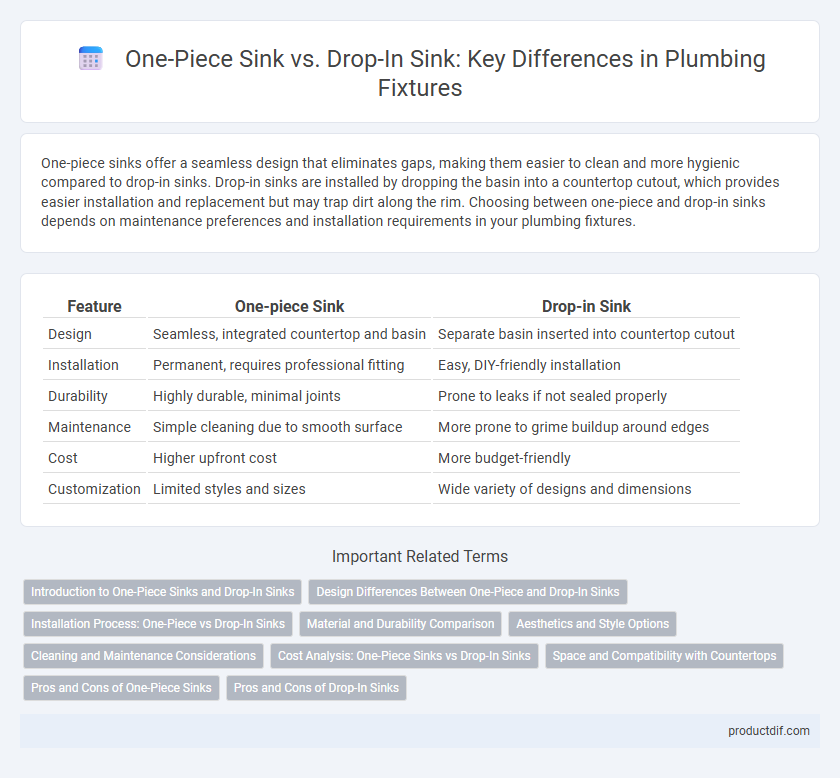One-piece sinks offer a seamless design that eliminates gaps, making them easier to clean and more hygienic compared to drop-in sinks. Drop-in sinks are installed by dropping the basin into a countertop cutout, which provides easier installation and replacement but may trap dirt along the rim. Choosing between one-piece and drop-in sinks depends on maintenance preferences and installation requirements in your plumbing fixtures.
Table of Comparison
| Feature | One-piece Sink | Drop-in Sink |
|---|---|---|
| Design | Seamless, integrated countertop and basin | Separate basin inserted into countertop cutout |
| Installation | Permanent, requires professional fitting | Easy, DIY-friendly installation |
| Durability | Highly durable, minimal joints | Prone to leaks if not sealed properly |
| Maintenance | Simple cleaning due to smooth surface | More prone to grime buildup around edges |
| Cost | Higher upfront cost | More budget-friendly |
| Customization | Limited styles and sizes | Wide variety of designs and dimensions |
Introduction to One-Piece Sinks and Drop-In Sinks
One-piece sinks are constructed from a single material piece, offering seamless durability and easy cleaning, typically made from stainless steel or composite materials. Drop-in sinks, also known as self-rimming sinks, fit into a pre-cut countertop hole, providing straightforward installation and a visible rim that helps contain spills. Both types serve diverse kitchen needs, with one-piece sinks favored for modern, sleek designs and drop-in sinks valued for their versatility and cost-effectiveness.
Design Differences Between One-Piece and Drop-In Sinks
One-piece sinks feature an integrated design where the sink basin and countertop form a seamless, unified surface, offering a sleek and modern appearance with fewer crevices for grime buildup. Drop-in sinks, also called top-mount sinks, are installed by dropping them into pre-cut countertop holes, creating a visible rim above the counter surface that can collect dirt and require more cleaning effort. The choice between these designs impacts kitchen aesthetics, ease of maintenance, and installation methods.
Installation Process: One-Piece vs Drop-In Sinks
One-piece sinks feature a seamless design that simplifies installation by eliminating the need for additional mounting hardware, allowing for quick attachment directly to countertops. Drop-in sinks require precise measurements and a cutout in the countertop, while the sink lip rests on the surface and is secured with clips and sealant to prevent leaks. Installation time for one-piece sinks is generally faster, making them ideal for DIY projects, whereas drop-in sinks offer more flexibility for countertop materials and styles.
Material and Durability Comparison
One-piece sinks are often made from durable materials like cast iron or solid surface composites, providing superior strength and resistance to chipping compared to drop-in sinks. Drop-in sinks typically use stainless steel or porcelain, which can be prone to dents or cracks over time, especially with heavy use. The seamless construction of one-piece sinks enhances durability by reducing potential weak points where damage or leaks might occur.
Aesthetics and Style Options
One-piece sinks offer sleek, seamless designs that enhance modern bathroom aesthetics by eliminating visible seams and edges. Drop-in sinks provide versatile style options with exposed rims that can complement traditional or rustic decors, allowing for easy customization with different countertop materials. Both sink types align with specific design preferences, where one-piece sinks emphasize minimalism and drop-in sinks prioritize decorative versatility.
Cleaning and Maintenance Considerations
One-piece sinks offer seamless surfaces with no crevices, reducing grime buildup and making cleaning more efficient compared to drop-in sinks that have edges where dirt and mold can accumulate. Drop-in sinks require more frequent scrubbing around the rim and caulking to prevent water damage and maintain hygiene. Selecting a sink with non-porous materials such as stainless steel or composite granite further enhances ease of maintenance and longevity.
Cost Analysis: One-Piece Sinks vs Drop-In Sinks
One-piece sinks typically have a higher initial cost due to integrated design and premium materials, while drop-in sinks are generally more affordable and easier to replace. Installation expenses for one-piece sinks can be lower because of fewer seams and simpler mounting, whereas drop-in sinks may incur additional labor costs related to sealing and fitting. Long-term maintenance costs favor one-piece sinks as they resist leaks and stains better than drop-in sinks, which often require more frequent repairs and cleaning.
Space and Compatibility with Countertops
One-piece sinks offer a seamless design that maximizes countertop space by integrating the basin and counter into a single unit, making them ideal for minimalist kitchens with limited area. Drop-in sinks provide greater compatibility with various countertop materials like laminate or wood due to their rimmed edges, allowing for easy installation and replacements. Space efficiency and material adaptability are key factors when choosing between one-piece and drop-in plumbing fixtures for different kitchen layouts.
Pros and Cons of One-Piece Sinks
One-piece sinks offer a seamless design that enhances durability and simplifies cleaning by eliminating crevices where dirt and grime can accumulate. They often provide a sleek and modern look, are easier to install due to integrated components, and reduce the risk of leaks compared to drop-in sinks. However, one-piece sinks can be more expensive upfront and may require professional installation, limiting DIY repair options and customization flexibility.
Pros and Cons of Drop-In Sinks
Drop-in sinks offer easy installation by simply dropping into a pre-cut hole on the countertop, making them ideal for DIY projects. Their raised edges help contain water spills, reducing the risk of countertop damage, but these edges can also collect dirt and require regular cleaning. While generally more affordable than one-piece sinks, drop-in sinks may lack the seamless appearance and water resistance offered by undermount or integrated sink designs.
One-piece sink vs Drop-in sink Infographic

 productdif.com
productdif.com